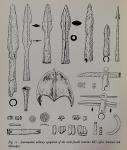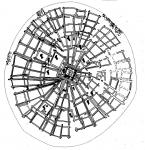Thank you, Michael
Good point: the Sargatskaya elite appears to have arrived from directly south, Massagetae country; and perhaps that impetus was in the iron-rich resources in the forest-steppe belt. Your other point, the probable use of heavy cavalry in the 529BC battle between Tomyris and Cyrus would be the force that tipped the scales.
I'm not sure if all the readers of this thread realize the nature and antiquity of "cavalry," or where it first arrived. If I might quote Stefan, "Cavalry is a military unit and thus the existence of the mass of armored riders needs to be demonstrated. However, with the possible exception of Assyrian reliefs I don't see any eastern literary of practical evidence which points to it."
Let me use Simonenko to illicit an educated answer, in this case the use of sophisticated armor, "Lamellar armour, very similar to the ones found in the Kuban river region, came from the graves of the Sargatskaya culture, Xiong-nu, Kang-hu, and Xsiang-bei graves. They were also present among the armour details of the settled neighbors in Bactria and China. Most likely, at that time there was a common model of the lamellar armor, with specific features for the different neighboring groups... Lamellar from the North Pontic Sarmatian graves constitute one more link of a chain connecting the origin of the Sarmatians with Inner Asia." (Simonenko, 2009)

Here we have an illustration of Sauromatae armor from the 6th to 4th centuries BC. Everything pictured smacks of the Massagetae weapons described in an earlier post by Herodotus plus more. We see contus heads, a Kuban helmet patterned after a Zhou one, the famed sagaris, and even pieces of lamellar and scale armor. In its entirety, it screams "cataphract."

Simonenko's other point, "connecting the origin of the Sarmatians with Inner Asia" actually refers us back to Mongolia, the cultural Heartland of Inner Asia, the birthplace of practical horse riding and cavalry itself. If I said "east of the Oxus," please modify it to Mongolia and Tuva (just above Mongolia). To have cavalry, we need horse riding. The photo above shows the broken bones of a woman (left) and man (right) dated to 1,350BC, the dawn of horse riding in Inner Asia and the oldest physical evidence found. The man had a broken leg bone, a broken nose, and his lower vertebrae were truncated and fused from horse back riding.

Likewise the concept of cavalry also comes from Inner Asia. The oldest Scythian kurgan excavated is Arzhan 1 in Tuva. It was designed like a circular khirigsuur and shallow, a "bridge" between the DSK Culture and evolving Scythians. Within the structure of 6,000 larch trees, the primary individual was centrally buried, his staff and consorts in various niches surrounding him. Yet we also see stacks of horses (the black clumps) which follow a numerical pattern, the largest being 30 horses, the smaller ones at 15. We are probably looking at cavalry units, a full detachment at 30. This individual was the "Big Man," the chieftain, the king, the High-General, the Emperor, whatever you want to call him... But, and this is important, he was the absolute leader of the oldest known structured cavalry. Important, that the concept of cavalry was Scythian, in this case proto-Scythian and dated to 800BC. All future, pastoral, cavalry cultures-- the Saka, the Massagetae, the Yuezhi, the Sargatskaya, and Sauromatians-- stem from this first one in Inner Asia. (Update: At present, Dr. Gino Caspari is excavating Tunnug 1, humorously called "Arzhan 0" because c14 dating places it older than Arzhan 1.)
Sophisticated cavalry of this type required armor, unless you were suicidal. That is the bottom line, and armor (usually in small fragments) shows up time and time again from China to the North Pontic steppes. Perhaps the value of time and material involved precluded its casual deposition in burials. But this does not mean it is absent, and here we have Sidorovka kurgan 1, "... a warrior with a full set of weaponry, including iron armor, a sword, a dagger, spearhead, bow and quiver." In the Isakovka kurgan 3, grave 6, "A wooden bed held the remains of a man dressed in golden textiles... The deceased wore a massive gold torque around his neck and one gold earring. Two gold plaques decorated his red belt, to which was attached a lacquer-covered scabbard [Chinese] holding a long iron sword. An iron dagger adorned with stone-inlaid gold plaques hung from the belt as well. In the [grave] corner were iron armor and a large iron belt." Both kurgans are dated from the 4th to 3rd century.
From the Arzhan potentate to the Sargatskaya chieftain, we find sophisticated leaders who knew how to win cavalry battles through the use of superb armor and crafty tactics. These men weren't riding around as well-dressed individuals chasing down some errant miscreant. They were tactical experts, and they were not just men. We have the horse-riding woman general in Baifu M2, buried with full horse gear and 60 weapons (just in case she lost one), her grave dated to the first generation of Zhou (1,045-1,015BC). Or we have Fu Jen, widow of a Yuezhi leader, who led her confederation of 150,000 cavalrymen against the Wusun (and winning) and then beating the Sacarauli in the Illi River Vally. We have the ultimate battle by Tomyris who was a tactical genius, but you know about that.
I do believe this post answers Stefan's doubts. One single and giant horse culture extended from Inner Asia into the Pontic steppe, and it was built on successful cavalry tactics through the use of shock tactics, sophisticated armor, long swords, and the contus.
Good point: the Sargatskaya elite appears to have arrived from directly south, Massagetae country; and perhaps that impetus was in the iron-rich resources in the forest-steppe belt. Your other point, the probable use of heavy cavalry in the 529BC battle between Tomyris and Cyrus would be the force that tipped the scales.
I'm not sure if all the readers of this thread realize the nature and antiquity of "cavalry," or where it first arrived. If I might quote Stefan, "Cavalry is a military unit and thus the existence of the mass of armored riders needs to be demonstrated. However, with the possible exception of Assyrian reliefs I don't see any eastern literary of practical evidence which points to it."
Let me use Simonenko to illicit an educated answer, in this case the use of sophisticated armor, "Lamellar armour, very similar to the ones found in the Kuban river region, came from the graves of the Sargatskaya culture, Xiong-nu, Kang-hu, and Xsiang-bei graves. They were also present among the armour details of the settled neighbors in Bactria and China. Most likely, at that time there was a common model of the lamellar armor, with specific features for the different neighboring groups... Lamellar from the North Pontic Sarmatian graves constitute one more link of a chain connecting the origin of the Sarmatians with Inner Asia." (Simonenko, 2009)
Here we have an illustration of Sauromatae armor from the 6th to 4th centuries BC. Everything pictured smacks of the Massagetae weapons described in an earlier post by Herodotus plus more. We see contus heads, a Kuban helmet patterned after a Zhou one, the famed sagaris, and even pieces of lamellar and scale armor. In its entirety, it screams "cataphract."
Simonenko's other point, "connecting the origin of the Sarmatians with Inner Asia" actually refers us back to Mongolia, the cultural Heartland of Inner Asia, the birthplace of practical horse riding and cavalry itself. If I said "east of the Oxus," please modify it to Mongolia and Tuva (just above Mongolia). To have cavalry, we need horse riding. The photo above shows the broken bones of a woman (left) and man (right) dated to 1,350BC, the dawn of horse riding in Inner Asia and the oldest physical evidence found. The man had a broken leg bone, a broken nose, and his lower vertebrae were truncated and fused from horse back riding.
Likewise the concept of cavalry also comes from Inner Asia. The oldest Scythian kurgan excavated is Arzhan 1 in Tuva. It was designed like a circular khirigsuur and shallow, a "bridge" between the DSK Culture and evolving Scythians. Within the structure of 6,000 larch trees, the primary individual was centrally buried, his staff and consorts in various niches surrounding him. Yet we also see stacks of horses (the black clumps) which follow a numerical pattern, the largest being 30 horses, the smaller ones at 15. We are probably looking at cavalry units, a full detachment at 30. This individual was the "Big Man," the chieftain, the king, the High-General, the Emperor, whatever you want to call him... But, and this is important, he was the absolute leader of the oldest known structured cavalry. Important, that the concept of cavalry was Scythian, in this case proto-Scythian and dated to 800BC. All future, pastoral, cavalry cultures-- the Saka, the Massagetae, the Yuezhi, the Sargatskaya, and Sauromatians-- stem from this first one in Inner Asia. (Update: At present, Dr. Gino Caspari is excavating Tunnug 1, humorously called "Arzhan 0" because c14 dating places it older than Arzhan 1.)
Sophisticated cavalry of this type required armor, unless you were suicidal. That is the bottom line, and armor (usually in small fragments) shows up time and time again from China to the North Pontic steppes. Perhaps the value of time and material involved precluded its casual deposition in burials. But this does not mean it is absent, and here we have Sidorovka kurgan 1, "... a warrior with a full set of weaponry, including iron armor, a sword, a dagger, spearhead, bow and quiver." In the Isakovka kurgan 3, grave 6, "A wooden bed held the remains of a man dressed in golden textiles... The deceased wore a massive gold torque around his neck and one gold earring. Two gold plaques decorated his red belt, to which was attached a lacquer-covered scabbard [Chinese] holding a long iron sword. An iron dagger adorned with stone-inlaid gold plaques hung from the belt as well. In the [grave] corner were iron armor and a large iron belt." Both kurgans are dated from the 4th to 3rd century.
From the Arzhan potentate to the Sargatskaya chieftain, we find sophisticated leaders who knew how to win cavalry battles through the use of superb armor and crafty tactics. These men weren't riding around as well-dressed individuals chasing down some errant miscreant. They were tactical experts, and they were not just men. We have the horse-riding woman general in Baifu M2, buried with full horse gear and 60 weapons (just in case she lost one), her grave dated to the first generation of Zhou (1,045-1,015BC). Or we have Fu Jen, widow of a Yuezhi leader, who led her confederation of 150,000 cavalrymen against the Wusun (and winning) and then beating the Sacarauli in the Illi River Vally. We have the ultimate battle by Tomyris who was a tactical genius, but you know about that.
I do believe this post answers Stefan's doubts. One single and giant horse culture extended from Inner Asia into the Pontic steppe, and it was built on successful cavalry tactics through the use of shock tactics, sophisticated armor, long swords, and the contus.

Alan J. Campbell
member of Legio III Cyrenaica and the Uncouth Barbarians
Author of:
The Demon's Door Bolt (2011)
Forging the Blade (2012)
"It's good to be king. Even when you're dead!"
Old Yuezhi/Pazyrk proverb
member of Legio III Cyrenaica and the Uncouth Barbarians
Author of:
The Demon's Door Bolt (2011)
Forging the Blade (2012)
"It's good to be king. Even when you're dead!"
Old Yuezhi/Pazyrk proverb






